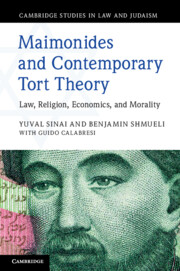Book contents
- Maimonides and Contemporary Tort Theory
- Cambridge Studies in Law and Judaism
- Maimonides and Contemporary Tort Theory
- Copyright page
- Contents
- Figures
- Introduction
- 1 Initial Presentation
- 2 Tort Liability in Maimonides’ Code:
- 3 The Foundations of the Maimonidean Theory:
- 4 The Deontological and Religious Elements of Maimonides’ Tort Theory
- 5 Consequentialist Considerations in the Guide for the Perplexed
- 6 Revisiting the Problematic Texts of the Code in Light of the Guide and Contemporary Scholarship
- 7 Maimonides’ Standard of Care:
- 8 Maimonides as a Pluralistic-Differential Scholar and Contemporary Tort Law Theories:
- 9 Reflections on Maimonides’ Tort Theory
- Index
7 - Maimonides’ Standard of Care:
A Differential Liability Model
Published online by Cambridge University Press: 10 August 2020
- Maimonides and Contemporary Tort Theory
- Cambridge Studies in Law and Judaism
- Maimonides and Contemporary Tort Theory
- Copyright page
- Contents
- Figures
- Introduction
- 1 Initial Presentation
- 2 Tort Liability in Maimonides’ Code:
- 3 The Foundations of the Maimonidean Theory:
- 4 The Deontological and Religious Elements of Maimonides’ Tort Theory
- 5 Consequentialist Considerations in the Guide for the Perplexed
- 6 Revisiting the Problematic Texts of the Code in Light of the Guide and Contemporary Scholarship
- 7 Maimonides’ Standard of Care:
- 8 Maimonides as a Pluralistic-Differential Scholar and Contemporary Tort Law Theories:
- 9 Reflections on Maimonides’ Tort Theory
- Index
Summary
Chapter 7 attempts to define accurately the standard of care adopted by Maimonides in his Code with respect to four categories of damage: (1) damage caused by a person to the property of another, (2) damage caused by a person who injures another, (3) damage caused by property, and (4) murder. In relation to each of these four categories, Maimonides proposed a standard of care that lies on the scale between fault, negligence, and strict liability. A careful examination of Maimonides’ writings reveals that he favored different liability regimes for different categories of damage. We present a scheme that illustrates Maimonides’ differential model and explains its rationale with respect to the hierarchy in the different standards of care applied in different cases. We also describe the historical background, circumstances, and nature of the tortfeasors in Maimonides’ time and in the contemporary era. This is essential for an understanding of the differential liability model in itself and as compared to contemporary models. Maimonides’ tort theory, we argue, is based upon a fundamental distinction between two questions: (1) upon whom should tort liability be imposed and (2) what is the standard of care that should be imposed in each case.
Keywords
- Type
- Chapter
- Information
- Maimonides and Contemporary Tort TheoryLaw, Religion, Economics, and Morality, pp. 310 - 337Publisher: Cambridge University PressPrint publication year: 2020

